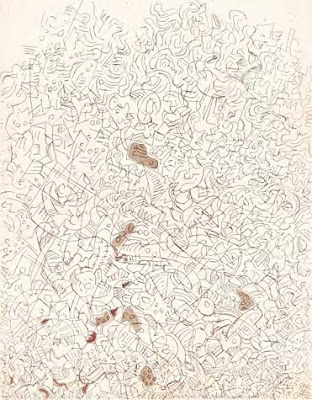If one distills the graphic arts (e.g., painting, drawing, printmaking, computer graphics, etc.) down to their most fundamental element, one finds the "mark." Marks are like building blocks in that they are individual and discrete, but can be used in a repetitive manner to render almost any visual effect. Marks can be highly gestural and expressive, or highly controlled and mechanical. The degree to which artists can achieve certain desired effects is in large measure determined by their choice of tool, the nature of the medium used, and the quality of the gesture employed. In 2-D Design, initial discussion centers around the expressiveness of the individual "mark"--its descriptive, expressive, and conceptual potentials.
Australian Aboriginal art

As one builds mark upon mark, a dynamic space for the interaction of marks and other elements of design such as lines and shapes emerges. A dynamic conception of this world would see the mark or point as having the potential for generating a line. Paul Klee explained the creation of expressive line as a matter of "taking a point for a walk " By extension, a plane can be seen as a moving line, and a three-dimensional volume can be understood as a moving plane (or line). This conceptualization of pictorial space is at least as old as Leonardo who discussed it in his notebooks. It finds a powerful set of exponents in the Bauhaus and, more recently, provides a clear basis for understanding the virtual 3-D space produced on the cathode ray tube (CRT) of a computer. Regardless of particular historical or technical biases, this conception of spatial description is a conceptually rich method of introducing the dynamic character of the picture plane. Consider how a point light source (e.g., a car head-light) will appear as a line in a time-exposure photograph. Or how a dancer's arm describes a plane in space.
Graffiti

What ever you try, students are encouraged to work through a lot of tools and media. Interact with one another, trade tools, and comparing notes.
Hohokam (Native Phoenix)
Can simple mark and line designs thoroughly express complex concepts of culture, world view, history etc?
Japanese Sumi-e









